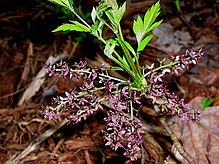Xanthorhiza
| Yellowroot | |
|---|---|
 |
|
| Yellowroot flowers in spring | |
| Scientific classification | |
| Kingdom: | Plantae |
| (unranked): | Angiosperms |
| (unranked): | Eudicots |
| Order: | Ranunculales |
| Family: | Ranunculaceae |
| Genus: |
Xanthorrhiza Marshall |
| Species: | X. simplicissima |
| Binomial name | |
|
Xanthorhiza simplicissima Marshall |
|
| Synonyms | |
|
Xanthorhiza apiifolia L'Hér. |
|
Xanthorhiza apiifolia L'Hér.
Xanthorhiza simplicissima (yellowroot) is the only member of the genus Xanthorhiza, and one of very few genera in the family Ranunculaceae with a woody stem (the other notable example being Clematis). It is native to the eastern United States from Maine south to northern Florida and west to Ohio and eastern Texas. It contains the alkaloid berberine, which has a number of traditional and contemporary uses for dyeing and medicine.
The genus name as well as the common name refer to the plant's yellow roots (xantho- meaning "yellow" and rhiza meaning "root"), which was used to produce a yellow dye by Native Americans. The species name refers to the simple (not branched) root.
In the wild, it grows on the edges of streams in sandy soil under a canopy of dappled sunlight. In cultivation, it is often provided with more sunlight so that the fall colors are more vivid. It is a subshrub, reaching 20–70 centimetres (8–28 in) (rarely 90 centimetres (35 in)) in height, with stems up to 6 millimetres (0.24 in) diameter. The leaves are spirally arranged, 10–18 centimetres (4–7 in) long, each divided into 5 toothed leaflets, and flowers emerge only from the upper portion of the unbranched stem. The flowers are produced in broad panicles 6–20 centimetres (2–8 in) long, each flower small, star-shaped, reddish brown to purple brown, with five petals.
Yellowroot propagates asexually by sending out many underground runners, and it reproduces sexually with seeds.
...
Wikipedia
